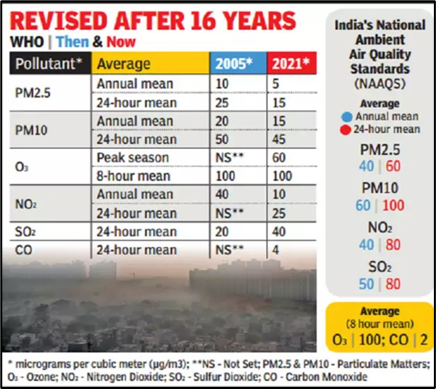Why in news?
A study by the Energy Policy Institute at the University of Chicago (EPIC) found that favorable meteorological conditions and slightly reduced emissions led to a decrease in PM2.5 pollution in India between 2021 and 2022. This, in turn, has contributed to a one-year increase in the country's average life expectancy.
The report also underlined that meeting the World Health Organization (WHO)’s pollution guidelines would increase Delhi residents’ life expectancy by 7.8 years.
What’s in today’s article?
- WHO’s revised air quality guidelines 2021
- Key highlights of the report
WHO’s revised air quality guidelines 2021

- In September 2021, the WHO has strengthened its air quality guidelines.
- The revised norms recommend air quality levels for six pollutants:
- Ozone, nitrogen dioxide, sulphur dioxide and carbon monoxide.
- The other two are PM10 and PM2.5 -- particulate matter equal or smaller than 10 and 2.5 microns in diameter.
- The recommended levels for all the six pollutants have been revised downwards from the existing norms that have been in place since 2005.
- The WHO norms are not binding on any country.
Key highlights of the report
- About the report
- The annual report, "Air Quality Life Index" 2024, has been released by the Energy Policy Institute at the University of Chicago (EPIC).
- The report involves an annual assessment of air quality worldwide, highlighting regions where standards have not been met and instances of policy successes and failures.
- Key highlights
- A dip in particulate pollution (PM2.5) in India between 2021 and 2022
- India recorded a significant 19.3% drop in particulate pollution in 2022 compared to 2021, the second-highest reduction in the world after Bangladesh.
- Decline in particulate pollution added an average of 51 days to the life expectancy of every citizen.
- The researchers attributed this decline to favourable meteorological conditions and a reduced number of thermal inversions.
- During thermal inversions, a layer of warm air traps cooler air near the ground, causing pollution to build up.
- Need to meet the WHO's annual PM2.5 concentration standard
- Indians are likely to lose 3.6 years of life expectancy if the country fails to meet the WHO's annual PM2.5 concentration standard of 5 micrograms per cubic metre.
- PM2.5 concentrations in India in 2022 were around 9 micrograms per cubic metre, 19.3% lower than 2021.
- Most significant declines
- The most significant declines were observed in Purulia and Bankura districts of West Bengal, followed by Dhanbad, Purbi, Paschim Singhbhum, Paschim Medinipur and Bokaro districts in Jharkhand.
- In each of these districts, PM2.5 concentrations dropped by over 20 micrograms per cubic metre.
- India's population still living in areas exceeding the national air quality standard
- 42.6% of India's population still lived in areas exceeding the national air quality standard.
- The report emphasizes that while air pollution remains the greatest external threat to life expectancy, setting and enforcing ambitious air quality standards could significantly improve public health.
- Impact of the National Clean Air Programme (NCAP)
- The report said that PM2.5 concentrations declined by 19% on average in districts with cities covered by India's flagship programme on air quality management, the National Clean Air Programme (NCAP).
- Launched in 2019, the NCAP is India's first national effort to set clean air targets.
- It aims for a 20-30% reduction in particulate pollution by 2024, using 2017 as the base year.
- The revised target is a 40% reduction by 2026, with 2019-20 as the base year.
- The programme covers 131 non-attainment cities, which consistently failed to meet the prescribed national ambient air quality standards between 2011 and 2015.
- Districts not covered by the programme saw a 16% decline.
- Innovative practices highlighted by the report
- In 2019, Gujarat launched the world's first market for particulate pollution, which has since reduced pollution by 20-30% in Surat and is rapidly expanding to other cities and states.
- These types of innovative policies demonstrate that it is possible to achieve improvements in air quality and people's health, without unduly impeding economic growth.
- The report also praised India's clean cooking programme, the Pradhan Mantri Ujjwala Yojana.
- The decline in emissions from the residential sector in India can largely be attributed to the nationwide rollout of this scheme.
- It attributed the reduction in transport-related emissions to the decreased use of diesel in the transport sector.










